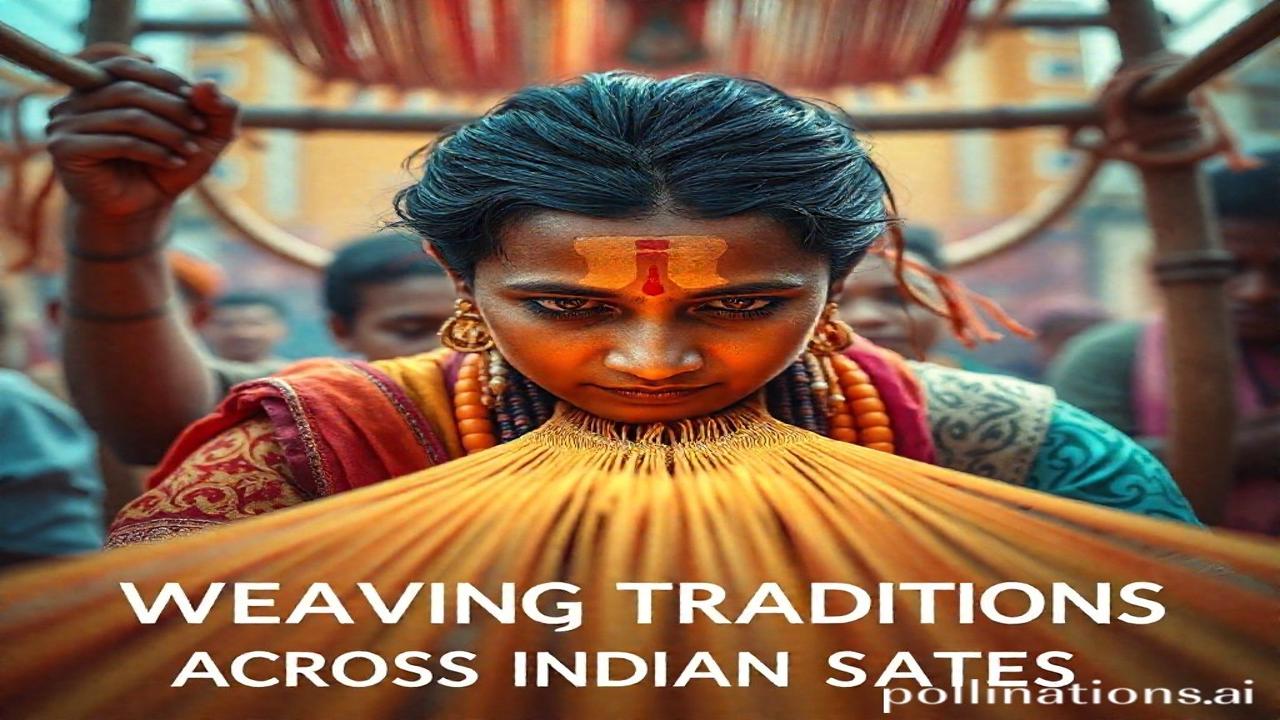Dhaage Dhaage, Bharat Rang: Weaving Traditions Across Indian States
Kabhi socha hai, ki agar ek dhaaga bol paata, toh wo kya kehta? Perhaps it would whisper tales of kings and queens, of bustling bazaars and quiet villages, of devotion and despair. The threads that crisscross India are more than just yarn; they’re stories spun across centuries, each knot a memory, each colour a song.
The Loom of Time: Historical & Cultural Context
We’re talking about the magnificent world of Indian textiles! From the silk of Varanasi to the cotton of Gujarat, from the intricate brocades of the South to the vibrant weaves of the Northeast, textile traditions are deeply interwoven with the history, culture, and identity of each Indian state. This isn’t just about clothing; it’s about कला (art), धरोहर (heritage), and a living testament to the skill and creativity of generations.
The story starts way back. Archaeological evidence suggests that cotton was cultivated and woven in the Indus Valley Civilization (around 3000 BCE). Trade routes like the Silk Road facilitated the exchange of techniques and materials, further enriching India’s weaving traditions. Different regions developed unique styles based on their local resources, climate, and cultural influences. Think of the Mughals, who patronized intricate embroidery like zardozi, or the influence of Persian motifs on Kashmiri shawls. Each period, each dynasty, left its mark on the loom.
A Tapestry of Techniques:
Each region boasts its own unique weaving techniques:
- Banarasi Silk (Uttar Pradesh): Known for its opulent gold and silver brocade, often used in wedding sarees.
- Kanjeevaram Silk (Tamil Nadu): Distinguished by its rich colours, zari borders, and temple motifs.
- Ikat (Odisha, Gujarat, Andhra Pradesh): A resist-dyeing technique where the threads are dyed before weaving, creating intricate patterns.
- Pashmina (Kashmir): Made from the fine fleece of the Changthangi goat, renowned for its softness and warmth.
- Khadi (Nationwide): Handspun and handwoven cotton, popularized by Mahatma Gandhi as a symbol of self-reliance.
Zameeni Sach: Log aur Jeevan
Imagine a weaver, sitting at his loom in a small village in Pochampally (Telangana). The rhythmic clack of the loom fills the air as his hands move deftly, interlacing threads to create a vibrant Ikat saree. His grandfather taught him the craft, and his father before him. It’s not just a job; it’s his dharma, his connection to his ancestors. “Yeh sirf kapda nahi hai,” he tells his son, “yeh hamari kahani hai, hamara itihaas hai.”
Ma Rukmini, wife of a Kanjeevaram weaver, carefully prepares the threads for dyeing. The air smells of natural dyes – turmeric, indigo, pomegranate rinds. She remembers her own wedding saree, a masterpiece woven by her father, adorned with motifs of peacocks and elephants, symbols of prosperity and good fortune. She hopes her daughter will wear a similar saree on her wedding day, continuing the tradition.
Think about the Mughal emperors, adorned in zardozi embroidered robes, dazzling in their grandeur. Or the freedom fighters, clad in simple Khadi, marching for Swaraj, a testament to the power of self-sufficiency.
Dharohar aur Pehchaan: Cultural Significance Today
Even today, Indian textiles hold immense cultural significance. Wedding sarees are heirlooms, passed down through generations. Festive attire often showcases regional weaves and embroideries. Khadi remains a symbol of sustainable fashion and national pride. From high-end designer collections to everyday wear, the influence of Indian textile traditions is undeniable.
They represent Bharatiyata in the purest form, connecting us to our roots and reminding us of the immense creativity and skill that exists within our communities. Wearing a handwoven saree or kurta isn’t just a fashion statement; it’s a celebration of our heritage, a way of honouring the artisans who keep these traditions alive.
Mazedar Tathya ya Bhram-Bhanjak
Myth-Buster: Log samajhte hain ki Khadi sirf cotton se banta hai. Lekin asli sach yeh hai ki Khadi wool aur silk se bhi banta hai! Khadi is defined by the process of hand-spinning and hand-weaving, not just the material.
Fun Fact: Did you know that the world’s finest muslin (a delicate cotton fabric) was originally produced in Bengal? It was so fine that it was said to be “woven air”!
Drishya aur Bhavnayen: Visual & Sensory Layer
Imagine walking through a bustling Varanasi bazaar. The air smells of incense and spices, the sounds of temple bells mingle with the calls of vendors. Heaps of colourful silk sarees shimmer under the sunlight. The walls of ancient temples are adorned with intricate carvings, echoing the patterns found in the textiles. The feel of soft Pashmina against your skin is a luxury, a whisper of the Himalayas.
The scent of natural dyes simmering in earthen pots, the rhythmic click-clack of the loom, the feel of rough Khadi against your skin – these are the sensory experiences that bring Indian textile traditions to life.
Antim Vichar ya Uddharan
“वस्त्रं भूषणं शान्तिः” (Vastram Bhushanam Shantih) – Clothing is an ornament, clothing is peace. More than just garments, Indian textiles are embodiments of our history, our culture, and our collective soul. They are a reminder that beauty can be found in the simplest of threads, and that the most enduring stories are woven with love, dedication, and a deep connection to tradition. So, the next time you see a piece of Indian textile, remember the stories it holds, the hands that created it, and the rich heritage it represents.
